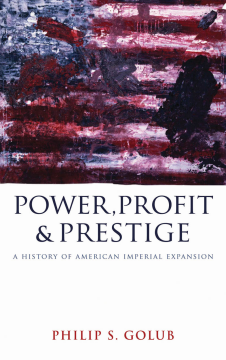
Additional Information
Book Details
Abstract
From the American Revolution, and the signing of the Declaration of Independence, to the waning popularity of the Iraq war, Philip Golub depicts the long American journey to global ascendancy.
Through the study of imperial identity formation, Golub shows how a culture of force and expansion has shaped American foreign policy. Taking a historical and sociological approach to his examination of the US logic of world power, he reveals how entrenched assumptions about America’s primacy inhibits democratic transformation at domestic and international levels, forging a new world where America is no longer able to set the global agenda.
'Lends realism to his historical interpretation of the rise of America's global empire during the past century and the crisis of its apparent decline during recent decades. The insightful book is an abundant resource for serious reflective thinking on the trajectory of world politics today'
Robert W. Cox
'A concise, well-judged and deeply informed analysis of the American empire. By taking a long historical view, Golub provides a full and wide-ranging examination of American conduct in the world'
Bruce Cumings, Gustavus F. and Ann M. Swift Distinguished Service Professor in History, University of Chicago
'Depicts the long American journey to global ascendancy that is now being eroded by decline, and challenged by emergent rivals, especially China. This sophisticated, deeply informed, and beautifully constructed book is essential reading for all wishing an understanding of world politics in the early 21st century'
Richard Falk
Table of Contents
| Section Title | Page | Action | Price |
|---|---|---|---|
| Cover | Cover | ||
| Contents | vii | ||
| List of Tables | ix | ||
| List of Figures | x | ||
| Acknowledgements | xi | ||
| Abbreviations | xii | ||
| 1. Introduction | 1 | ||
| EXPANSIONIST BEHAVIOUR | 4 | ||
| A HISTORICAL SOCIOLOGICAL APPROACH | 6 | ||
| THEORISING AMERICAN EMPIRE | 10 | ||
| AN INDETERMINATE FUTURE | 15 | ||
| STRUCTURE OF THE BOOK | 17 | ||
| 2. The American Empire in its World Historical Setting | 20 | ||
| A PLURAL AND POLYCENTRIC WORLD ECONOMY | 21 | ||
| THE DISTINCTIVENESS OF WESTERN GLOBAL EXPANSION | 26 | ||
| GLOBALISATION AND WAR | 29 | ||
| THE UNITED STATES IN THE TRANSATLANTIC IMPERIAL SYSTEM | 33 | ||
| 3. A Taste of Blood in the Jungle: The Late Nineteenth Century | 41 | ||
| THE US: AN ‘ACTIVE UNIT’ | 42 | ||
| OVERSEAS IMPERIALISM | 45 | ||
| INTER-IMPERIAL LINKS AND RIVALRIES | 53 | ||
| WILSON, LIBERAL INTERNATIONALISM AND ULTRA-IMPERIALISM | 57 | ||
| 4. The Hierarchies of Pax Americana | 63 | ||
| SUPPLANTING BRITAIN | 64 | ||
| THE TRIPARTITE IMPERIAL SYSTEM | 66 | ||
| EUROPE: THE HEGEMONIC FRONTIER | 69 | ||
| AUTHORITARIAN MERCANTILISM: THE EAST ASIAN FRONTIER | 73 | ||
| DISCIPLINING THE FAR EMPIRE | 77 | ||
| 5. Power and Plenty in the Post-Cold War | 81 | ||
| THE IMPERIUM BELLICUM AMERICANUM | 81 | ||
| AVERTING DECLINE | 85 | ||
| ACTOR DESIGNS AND STRUCTURAL CONSTRAINTS | 88 | ||
| POST-COLD WAR OPTIONS | 93 | ||
| THE LIBERAL INTERLUDE | 98 | ||
| 6. Striving for Global Monopoly | 104 | ||
| A BROAD IDEATIONAL TREND | 105 | ||
| GLOBAL EXPANSIONISM AND NATIONALISM | 107 | ||
| LIMITLESS GOALS | 114 | ||
| LIBERAL IMPERIALISM, COLONIAL REPRESENTATIONS | 119 | ||
| 7. Losing Control | 125 | ||
| WAR AND GLOBALISATION | 126 | ||
| THE CRISIS OF AMERICAN POWER | 129 | ||
| ACCENTUATING CENTRIFUGAL TRENDS | 133 | ||
| CHINA’S EMERGING ROLE | 138 | ||
| CHALLENGE TO US DOMINANCE | 141 | ||
| 8. Conclusion: Order, Hierarchy and Pluralism | 143 | ||
| IMPERIAL COSMOLOGIES | 143 | ||
| LOGIC OF WORLD POWER | 146 | ||
| PATHWAYS OF CHANGE | 149 | ||
| LONG EXIT FROM EMPIRE | 151 | ||
| PLURALIST COOPERATION | 153 | ||
| Notes | 155 | ||
| Select Bibliography | 200 | ||
| Index | 217 |
